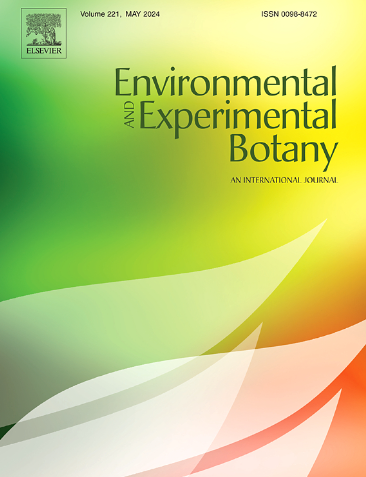盐碱地梭梭代谢和抗氧化反应驱动梭梭适应盐水和淡水滴灌
IF 4.7
2区 生物学
Q2 ENVIRONMENTAL SCIENCES
引用次数: 0
摘要
盐水灌溉是解决淡水短缺和恢复盐碱地的一种有希望的策略,但植物适应不同盐条件的分子机制仍然知之甚少。本文研究了梭梭(Haloxylon ammodendron, H。利用综合转录组学和代谢组学分析以及动态土壤离子监测,在盐碱土壤中梭梭(Ammodendron)对淡水和盐水滴灌的影响。淡水灌溉通过浸出暂时降低了土壤中Na⁺和Cl⁻的含量,但导致了Ca 2 +和SO₄2⁻的积累,而盐水灌溉最初增加了Na⁺和Cl⁻的浓度,然后实现了离子的再平衡和pH的稳定。转录组学分析揭示了不同的分子响应:淡水灌溉诱导了1305个主要与次级代谢物生物合成和抗氧化途径相关的差异表达基因,而盐水灌溉激活了825个富含碳水化合物代谢和类黄酮生物合成的基因。代谢组学分析显示,淡水灌溉条件下差异表达的代谢物数量较多,特别是有机酸和氨基酸。相关分析表明,盐水灌溉通过抑制基因表达和代谢途径重建来增强盐耐受性,特别是涉及能够精确适应盐波动的关键类黄酮生物合成基因(SS2296411, SS3033913)。这些发现揭示了梭梭在盐胁迫下通过动态调节次生代谢、能量平衡和抗氧化系统来维持生理稳态,为通过定向基因工程优化咸水利用和培育耐盐作物提供了理论基础。本文章由计算机程序翻译,如有差异,请以英文原文为准。
Metabolic and antioxidant responses drive Haloxylon ammodendron’s adaptation to drip irrigation with saline and freshwater in saline-alkali soils
Saline water irrigation represents a promising strategy for addressing freshwater scarcity and rehabilitating saline-alkali lands, yet the molecular mechanisms underlying plant adaptation to varying salt conditions remain poorly understood. This study investigated the molecular responses of Haloxylon ammodendron(H. ammodendron) to freshwater versus saline water drip irrigation in saline-alkali soils using integrated transcriptomic and metabolomic analyses coupled with dynamic soil ion monitoring. Freshwater irrigation temporarily reduced soil Na⁺ and Cl⁻ levels through leaching but caused Ca²⁺ and SO₄²⁻ accumulation, while saline water irrigation initially increased Na⁺ and Cl⁻ concentrations before achieving ion rebalancing and pH stabilization. Transcriptomic analysis revealed distinct molecular responses: freshwater irrigation induced 1305 differentially expressed genes primarily associated with secondary metabolite biosynthesis and antioxidant pathways, whereas saline water irrigation activated 825 genes enriched in carbohydrate metabolism and flavonoid biosynthesis. Metabolomic profiling showed higher numbers of differentially expressed metabolites under freshwater irrigation, particularly organic acids and amino acids. Correlation analysis demonstrated that saline water irrigation enhances salt tolerance through suppressed gene expression and metabolic pathway reconstruction, notably involving key flavonoid biosynthesis genes (SS2296411, SS3033913) that enable precise adaptation to salt fluctuations. These findings reveal that H. ammodendron maintains physiological homeostasis under salt stress by dynamically regulating secondary metabolism, energy balance, and antioxidant systems, providing theoretical foundations for optimizing saline water utilization and developing salt-tolerant crops through targeted genetic engineering.
求助全文
通过发布文献求助,成功后即可免费获取论文全文。
去求助
来源期刊

Environmental and Experimental Botany
环境科学-环境科学
CiteScore
9.30
自引率
5.30%
发文量
342
审稿时长
26 days
期刊介绍:
Environmental and Experimental Botany (EEB) publishes research papers on the physical, chemical, biological, molecular mechanisms and processes involved in the responses of plants to their environment.
In addition to research papers, the journal includes review articles. Submission is in agreement with the Editors-in-Chief.
The Journal also publishes special issues which are built by invited guest editors and are related to the main themes of EEB.
The areas covered by the Journal include:
(1) Responses of plants to heavy metals and pollutants
(2) Plant/water interactions (salinity, drought, flooding)
(3) Responses of plants to radiations ranging from UV-B to infrared
(4) Plant/atmosphere relations (ozone, CO2 , temperature)
(5) Global change impacts on plant ecophysiology
(6) Biotic interactions involving environmental factors.
 求助内容:
求助内容: 应助结果提醒方式:
应助结果提醒方式:


